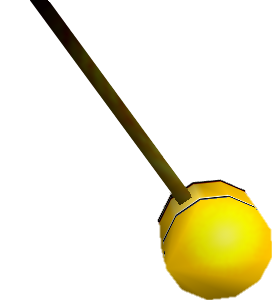Pendulum
| Pendulum | |||

| |||
| Hitbox Info | |||
| Hitbox | |||
| Damage | none | ||
| Damage without hat | none | ||
| Tangibility radius | 1500 | ||
| Interaction type | none | ||
| Surfaces | floor: , wall: , ceil: | ||
| |||
| |||
Pendulums are objects found in Tick Tock Clock. The pendulum swings and is dependent on the setting of the clock.
Behavior
The pendulum starts at angle = 6371.5557 (35 degrees) on the still setting and angle = 6500 on all other settings. From there, the pendulum behaves differently on all four clock settings.
Still Setting
The pendulum is still on the still setting.
Fast Setting
The pendulum swings fast on the fast setting.
Slow Setting
The pendulum swings slow on the slow setting.
Random Setting
The pendulum swings with an angular acceleration of 13 or 42, randomly, on the random setting. When a swing didn't pass angle=0 (when the pendulum points straight down), and subsequent swings swap angular accelerations, every swing will have a different amplitude. By manipulating RNG, the pendulum can be made swing with a TASer's desired acceleration. Alternating acceleration 13 and 42 until the pendulum hits angle=0, then manipulating acceleration to keep the acceleration the same value for all future swings, allows the pendulum to swing much farther than it was intended to; this is known as Pendulum Manipulation.
A set of swing amplitudes that are connected by swings of alternating accelerations usually starts and ends with two equal and opposite swings that both pass angle=0. When placed in increasing order, these sets of swing amplitudes form the shape of a ladder and are called the steps of the ladder and the swings that pass angle=0 are called rail amplitudes, forming the rails of the ladder. The acceleration that allows them to pass angle=0, and the frames it takes to reach angle=0 are indices of the rail.
Sometimes, a rail is sandwiched by two different rail amplitudes. This forms a bridge between the two rail amplitudes.
References
| |||||||||||||||||||||||||||||